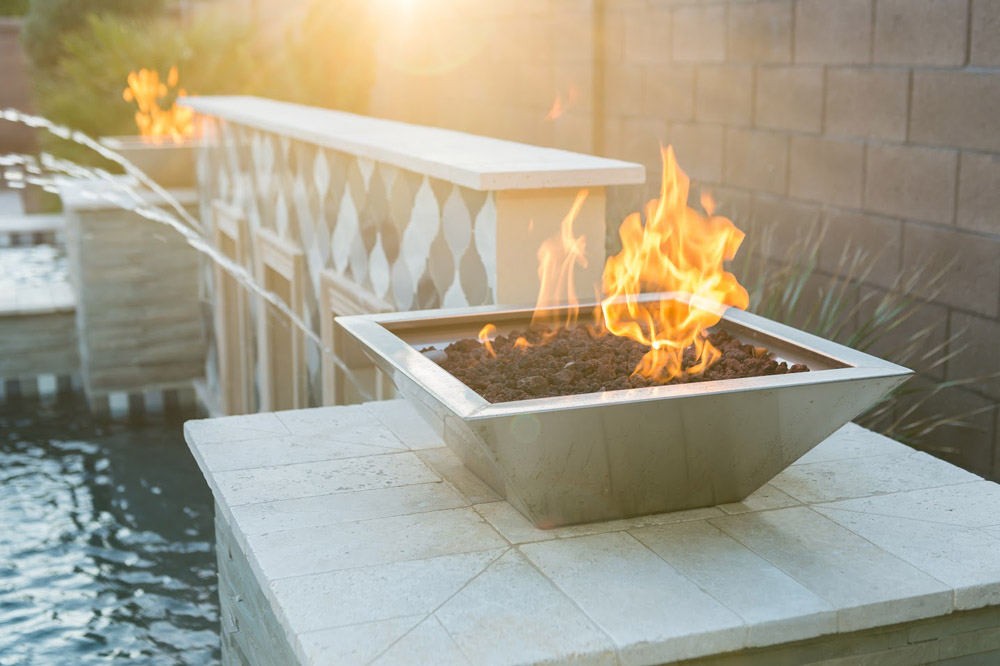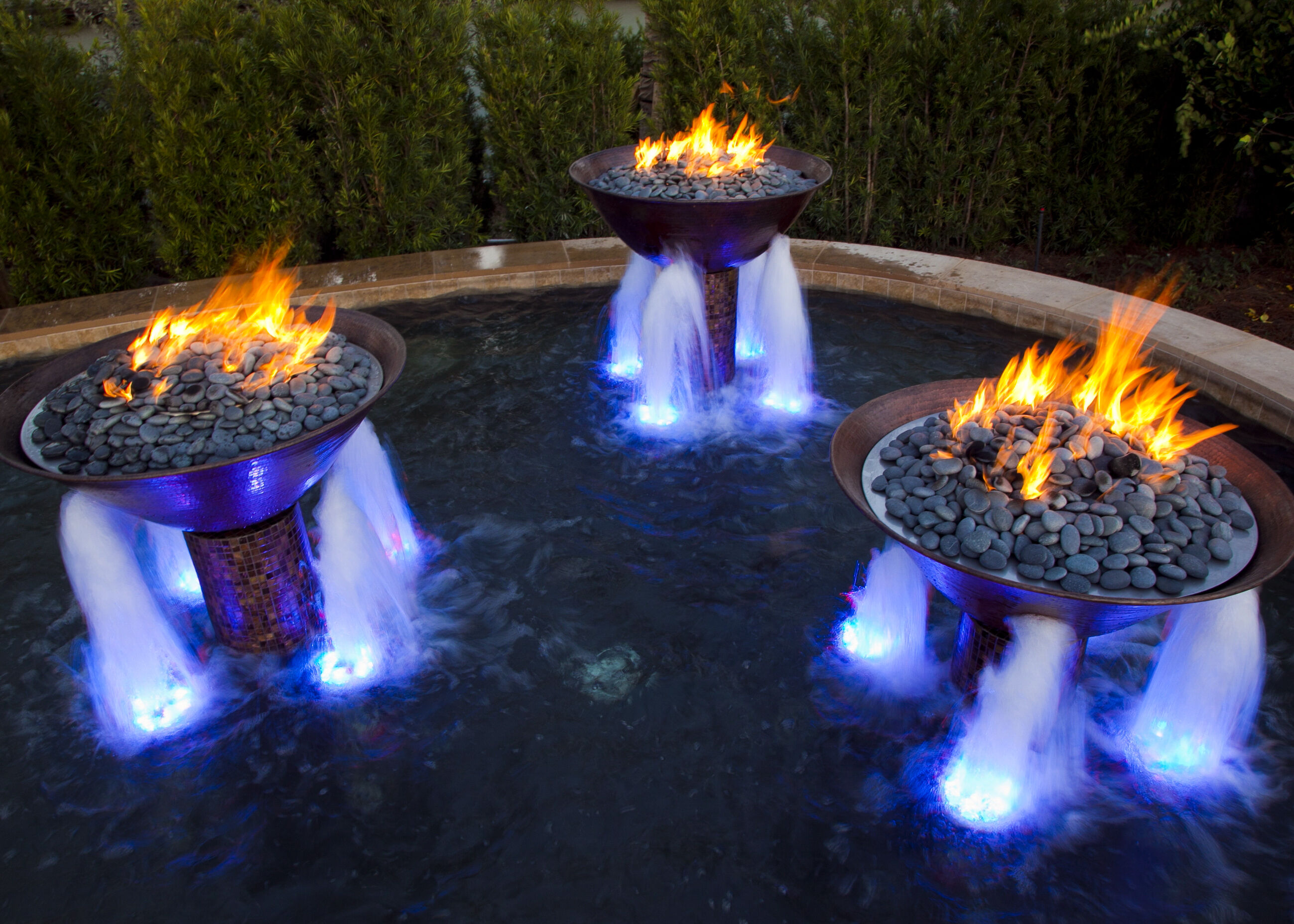Call us at 725-239-9966!
M-F: 8 AM-7 PM PST
Call us at 725-239-9966!
M-F: 8 AM-7 PM PST

A fire water feature is a unique outdoor heating fixture that provides warmth and ambiance to any patio, backyard, or outdoor space. But how exactly do these fire pits produce heat, and how much warmth can you expect from them? What factors determine the heat output and heating capacity of a fire bowl? Let's find out.

A fire bowl can produce between 10,000 to over 100,000 BTUs (British Thermal Units) of heat energy per hour depending on its size, fuel type, ventilation design, and other factors.
The fuel type used - wood, propane gas, natural gas, or bioethanol - significantly impacts the heat output and performance.
In addition to the fuel type, the combustion efficiency and heat output of a fire bowl depends on:
With an understanding of the fuel options and heat generation process, we can now quantify and compare the heating capacities of different fire bowl models.


The heating capacity of fire bowls is measured in British Thermal Units (BTUs) or Kilowatts (KW). BTU indicates the amount of heat energy produced, while KW denotes the rate of heat generation.
So a fire bowl rated at 50,000 BTUs generates 50,000 British Thermal Units of heat energy every hour when operating at full capacity. The higher the BTU, the greater the heat output.
Typical BTU Ranges for Fire Bowls:
These values may vary between models based on shape, ventilation, accessories (lids, screens), etc. Outdoor installations also need higher BTU for heating larger areas.
Besides the heat output, positioning is also vital for fire bowls to warm your intended zone effectively. The typical heating area for a fire bowl is approximately 1 square foot per 1,000 BTUs.
For example:
However, the actual area covered depends on:
To calculate the approximate zone of influence of a fire bowl based on its BTU rating, you can use the following formula:
Zone of influence (in feet)= Under Root (BTU rating ×10/10,000)
For example, if a fire bowl has a 60,000 BTU rating, its zone of influence is:
This means it can effectively heat a 24-foot diameter area around it. Position your seating/dining arrangements accordingly to enjoy the warmth.

While ambiance and warmth may be the main attractions of fire bowls, safety should be your number one priority with open flames. Consider these precautions:
Check local regulations about outdoor fire codes and weather conditions before use.
A final key factor in fire bowl satisfaction is choosing the right heating capacity for your goals and optimizing setup and operation.
Considerations for an ideal fire bowl experience include:
1. Match BTU rating to space size
Choose too small, and the heat won't meet expectations. Too large becomes overpowering. Use our BTU guideline of 100 BTUs per square foot of area.
2. Position to maximize heat diffusion
Angle to radiate warmth over seating areas vs wasting heat skyward.
3. Adjust flame for conditions
Turn up the heat output for colder nights or when entertaining larger groups.
4. Add fire glass or lava rock
This absorbs and emits warmth more effectively than grates alone while adding color and dimension.
5. Install a cooking grate or specialty accessory
Take full advantage of your heat source for grilling, smoking, or s'more making!
6. Use automatic timer or thermostats
Conserve fuel and simplify fire management with smart controls.
7. Inspect, clean, and protect when not in use
Ensure safe operation and extend the longevity of your fire bowl asset.

The heating capacity provides valuable insight into the warmth potential of any prospective fire bowl purchase. Combined with the proper clearance, ventilation precautions, and operating practices, fire bowls serve as a spectacular heat source and backyard focal point for years of enjoyment.
When choosing the ideal fire bowl, also reference our detailed buying guide on fire bowls comparing top-rated fire and water bowls on the market. Size it right for your outdoor living space, match it to local climate conditions, and take advantage of the glow and warmth a fire feature offers!
Both gas and wood burning fire bowls produce heat, but they do it in different ways. A gas fire bowl burns either propane or natural gas to produce heat and then radiate it, providing heat to the surrounding area. A wood-burning fire pit generates heat by burning wood, which gives off heat as it combusts. However, the heat from a wood-burning fire pit may not be as consistent or easy to control as that from a gas fire pit.
While propane and natural gas fire bowls can both provide a good amount of warmth, propane fire pits generally burn hotter and thus can produce higher heat output. The amount of heat a fire bowl gives off is often measured in BTUs, and propane generally has more BTUs per cubic foot than natural gas.
There are a few tricks to get your fire bowl to provide more heat. For gas fire bowls, you may consider buying a model with a higher BTU rating. For wood-burning fire bowls, using denser wood can lead to longer, hotter fires. It's also beneficial to keep the fire well-ventilated and to periodically clean out the ashtray to maintain optimal performance.
A gas fire bowl kit is a popular choice for outdoor heating, and for good reason. They provide concentrated warmth to the immediate area around the fire pit, making them ideal for intimate gatherings.
Fire bowls that have a higher BTU rating and a deeper, wider construction usually produce more heat. Thus, propane fire bowls, with their higher BTU outputs and efficient burning, maybe a good option for those in search of maximum heat. For wood-burning fire pits, models that allow for larger logs will likely produce more heat.
The material of the fire pit can significantly affect its heat emission as different materials absorb and radiate heat differently. Fire pits made from denser materials like cast iron or steel tend to retain heat longer and give off intense heat. On the other hand, fire pits made from aluminum or other lightweight materials might provide less heat as they don't retain the heat as well.

{"one"=>"Select 2 or 3 items to compare", "other"=>"{{ count }} of 3 items selected"}